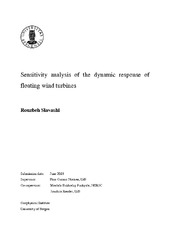| dc.description.abstract | Development of offshore wind turbines shows a clear shift from the fixed-bottom turbines to the floating turbines. The reason for such tendency is due to the fact that moving towards the deep ocean will substantially limit the feasibility of using fixed-bottom wind turbines because of several significant operational and environmental constraints. For such conditions, the floating turbine concepts, adopted from the offshore oil and gas industries, will be able to maximize the wind power extraction by increasing the structural reliability and decreasing the construction cost. Difficulties of structural design and development in the offshore wind energy industry, due to complex nature of offshore loading and structural responses (rotating mass, mooring tension, etc.), can be substantially reduced by utilizing accurate and reliable hydro- and aerodynamic numerical models. In this master thesis, focus is on investigating the structural responses of two spar-buoy floating offshore wind turbines, i.e. Hywind Demo (2.3 MW) and OC3-Hywind (5 MW). The dynamic responses of Hywind Demo and OC3-Hywind due to the combined action of wind and waves are numerically simulated by the computational tool SIMA (Simulation of Marine Operations). To ensure the performance of numerical simulations in order to capture efficiently the physical behaviour of the offshore wind turbines, model simulation results are required to be verified against the available reliable structural measurements. The numerical model of Hywind Demo has previously been compared to full scale measurements. In this master thesis to extend the previous study, by using the measured environmental and dynamic responses as a reference, a sensitivity study is performed to better understand the sensitivity of various structural responses, such as e.g. platform pitch, as function of the various environmental parameters, such as e.g. turbulence intensity. Moreover, the same sensitivity study will be applied to OC3-Hywind to better understand of the responses of bigger wind turbine compared to the smaller one, i.e. Hywind Demo. The results show a high sensitivity of the investigated structural responses to the wave characteristics and turbulence intensity variations. Moreover, the analyses show more sensitivity of the local structural responses than global structural responses to alpha variation in wind shear profile power law. Also, the sensitivity to spatial variation of numerical wind field has a fluctuation pattern. Furthermore, OC3-Hywind has greater structural responses because of bigger rotor diameter and more weight than Hywind Demo. Co-coherence of longitudinal wind velocity fluctuation (uˊ) shows higher correlation between nodes for lower frequency than higher frequency for one realization. | en_US |
